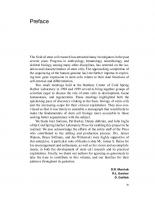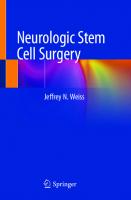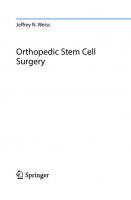Perspectives in Stem Cell Research [1 ed.] 9781620819937, 9781611229851
Stem cells are cells found in all multi cellular organisms. They are characterized by the ability to renew themselves th
210 88 7MB
English Pages 396 Year 2011
Recommend Papers
![Perspectives in Stem Cell Research [1 ed.]
9781620819937, 9781611229851](https://ebin.pub/img/200x200/perspectives-in-stem-cell-research-1nbsped-9781620819937-9781611229851.jpg)
- Author / Uploaded
- Brenda M. Davis
- Christopher B. Halton
File loading please wait...
Citation preview
Copyright © 2011. Nova Science Publishers, Incorporated. All rights reserved. Perspectives in Stem Cell Research, Nova Science Publishers, Incorporated, 2011. ProQuest Ebook Central,
Copyright © 2011. Nova Science Publishers, Incorporated. All rights reserved. Perspectives in Stem Cell Research, Nova Science Publishers, Incorporated, 2011. ProQuest Ebook Central,
Copyright © 2011. Nova Science Publishers, Incorporated. All rights reserved. Perspectives in Stem Cell Research, Nova Science Publishers, Incorporated, 2011. ProQuest Ebook Central,
STEM CELLS – LABORATORY AND CLINICAL RESEARCH
Copyright © 2011. Nova Science Publishers, Incorporated. All rights reserved.
PERSPECTIVES IN STEM CELL RESEARCH
No part of this digital document may be reproduced, stored in a retrieval system or transmitted in any form or by any means. The publisher has taken reasonable care in the preparation of this digital document, but makes no expressed or implied warranty of any kind and assumes no responsibility for any errors or omissions. No liability is assumed for incidental or consequential damages in connection with or arising out of information contained herein. This digital document is sold with the clear understanding that the publisher is not engaged in rendering legal, medical or any other professional services.
Perspectives in Stem Cell Research, Nova Science Publishers, Incorporated, 2011. ProQuest Ebook Central,
STEM CELLS – LABORATORY AND CLINICAL RESEARCH Additional books in this series can be found on Nova‘s website under the Series tab.
Copyright © 2011. Nova Science Publishers, Incorporated. All rights reserved.
Additional E-books in this series can be found on Nova‘s website under the E-books tab.
Perspectives in Stem Cell Research, Nova Science Publishers, Incorporated, 2011. ProQuest Ebook Central,
STEM CELLS – LABORATORY AND CLINICAL RESEARCH
PERSPECTIVES IN STEM CELL RESEARCH
BRENDA M. DAVIS AND Copyright © 2011. Nova Science Publishers, Incorporated. All rights reserved.
CHRISTOPHER B. HALTON EDITORS
Nova Science Publishers, Inc. New York
Perspectives in Stem Cell Research, Nova Science Publishers, Incorporated, 2011. ProQuest Ebook Central,
Copyright © 2011 by Nova Science Publishers, Inc. All rights reserved. No part of this book may be reproduced, stored in a retrieval system or transmitted in any form or by any means: electronic, electrostatic, magnetic, tape, mechanical photocopying, recording or otherwise without the written permission of the Publisher. For permission to use material from this book please contact us: Telephone 631-231-7269; Fax 631-231-8175 Web Site: http://www.novapublishers.com NOTICE TO THE READER The Publisher has taken reasonable care in the preparation of this book, but makes no expressed or implied warranty of any kind and assumes no responsibility for any errors or omissions. No liability is assumed for incidental or consequential damages in connection with or arising out of information contained in this book. The Publisher shall not be liable for any special, consequential, or exemplary damages resulting, in whole or in part, from the readers‘ use of, or reliance upon, this material. Any parts of this book based on government reports are so indicated and copyright is claimed for those parts to the extent applicable to compilations of such works.
Copyright © 2011. Nova Science Publishers, Incorporated. All rights reserved.
Independent verification should be sought for any data, advice or recommendations contained in this book. In addition, no responsibility is assumed by the publisher for any injury and/or damage to persons or property arising from any methods, products, instructions, ideas or otherwise contained in this publication. This publication is designed to provide accurate and authoritative information with regard to the subject matter covered herein. It is sold with the clear understanding that the Publisher is not engaged in rendering legal or any other professional services. If legal or any other expert assistance is required, the services of a competent person should be sought. FROM A DECLARATION OF PARTICIPANTS JOINTLY ADOPTED BY A COMMITTEE OF THE AMERICAN BAR ASSOCIATION AND A COMMITTEE OF PUBLISHERS. Additional color graphics may be available in the e-book version of this book.
LIBRARY OF CONGRESS CATALOGING-IN-PUBLICATION DATA Perspectives in stem cell research / editors, Brenda M. Davis and Christopher B. Halton. p. cm. Includes index. ISBN 978-1-62081-993-7 (E-Book) 1. Stem cells. I. Davis, Brenda M. II. Halton, Christopher B. QH588.S83P475 2010 616'.02774--dc22 2010047112
Published by Nova Science Publishers, Inc. † New York Perspectives in Stem Cell Research, Nova Science Publishers, Incorporated, 2011. ProQuest Ebook Central,
CONTENTS
Copyright © 2011. Nova Science Publishers, Incorporated. All rights reserved.
Preface
vii
Chapter I
Stem Cell Research Judith A. Johnson and Erin Williams
Chapter II
Cancer Stem Cells Saranya Chumsri and Angelika M. Burger
29
Chapter III
Prostate Stem Cells Aamir Ahmed, Isabelle Bisson, Charlotte L. Foley and John R. W. Masters
43
Chapter IV
Mesenchymal Stem Cells in Vascular Therapy Gael Y. Rochefort
59
Chapter V
Neural Stem Cells and Taurine Eulalia Bazán, Antonio S. Herranz, Diana Reimers, Maria V.T. Lobo, Carolina Redondo, Miguel A. López-Toledano, Rafael Gonzalo-Gobernado, Maria J. Asensio and Raquel Alonso
Chapter VI
Circulating Endothelial Progenitor Cells: Relevant in Physiopathology, A Promise for Clinical Applications, and Yet so Difficult to be Characterized Margherita Massa, Rita Campanelli and Vittorio Rosti
Chapter VII
Chapter VIII
Chapter IX
1
139
155
Red Blood Cell Transfusions in the Era of Reduced Intensity Conditioning Allogeneic Stem Cell Transplantation Vadim Ivanov, Mohamad Mohty and Didier Blaise
185
Interactions between Transplanted Neural Stem Cells and Host Tissue: A Two-Way Street Teresita L. Briones
209
Retrovirus Vector Silencing in Stem Cells Shuyuan Yao and James Ellis
233
Perspectives in Stem Cell Research, Nova Science Publishers, Incorporated, 2011. ProQuest Ebook Central,
vi Chapter X
Chapter XI
Chapter XII
Contents Migration of Hematopoietic Stem/Progenitor Cells in Health and Disease Susannah H. Kassmer, Jeanette Seidel, Bernd Niggemann, Kurt S. Zänker and Thomas Dittmar
271
Moral and Scientific Considerations in Embryonic Stem Cell Research Zubin Master, Daisy Laforce, Marcus McLeod and Bryn Williams-Jones
291
Background and Legal Issues Related to Stem Cell Research Diane T. Duffy
343
Copyright © 2011. Nova Science Publishers, Incorporated. All rights reserved.
Index
Perspectives in Stem Cell Research, Nova Science Publishers, Incorporated, 2011. ProQuest Ebook Central,
351
Copyright © 2011. Nova Science Publishers, Incorporated. All rights reserved.
PREFACE Stem cells are cells found in all multi cellular organisms. They are characterized by the ability to renew themselves through mitotic cell division and differentiate into a diverse range of specialized cell types. This book presents and discusses current research in the study of stem cell research, including cancer and prostate stem cells; neural stem cells and taurine; interactions between transplanted neural stem cells and host tissue; retrovirus vector silencing in stem cells and moral and scientific consideration in embryonic stem cell research. Chapter 1 - Embryonic stem cells have the ability to develop into virtually any cell in the body, and may have the potential to treat medical conditions such as diabetes and Parkinson‘s disease. In August 2001, President Bush announced that for the first time federal funds would be used to support research on human embryonic stem cells, but funding would be limited to ―existing stem cell lines.‖ The National Institutes of Health (NIH) has established the Human Embryonic Stem Cell Registry which lists stem cell lines that are eligible for use in federally funded research. Although 78 cell lines are listed, 21 embryonic stem cell lines are currently available. Scientists are concerned about the quality, longevity, and availability of the eligible stem cell lines. For a variety of reasons, many believe research advancement requires new embryonic stem cell lines, and for certain applications, stem cells derived from cloned embryos may offer the best hope for progress in understanding and treating disease. A significant cohort of pro-life advocates support stem cell research; those opposed are concerned that the isolation of stem cells requires the destruction of embryos. Letters from Congress, one signed by 206 Members of the House and a second signed by 58 Senators, have been sent urging President Bush to expand the current federal policy concerning embryonic stem cell research. Chapter 2 - Emerging evidence suggests that cancers contain a rare and biologically distinct subpopulation of cells with the ability to self-renew and to sustain tumor growth, termed ―cancer stem cells‖. Cancer stem cells share many characteristics with normal stem cells including self-renewal, asymmetric division, indefinite proliferative capacity, and selfprotection mechanisms. The cancer stem cell concept is best understood in hematologic malignancies. In solid tumors, breast cancer stem cells have been the most explored. Several techniques have been described, allowing the identification or isolation of cancer stem cells by either expression of specific cell surface markers, their differential ability to efflux dyes, or by a distinct enzymatic activity. More recent studies also established the crucial role of cancer stem cells in multistage cancer progression and metastasis which has important implications
Perspectives in Stem Cell Research, Nova Science Publishers, Incorporated, 2011. ProQuest Ebook Central,
Copyright © 2011. Nova Science Publishers, Incorporated. All rights reserved.
viii
Brenda M. Davis and Christopher B. Halton
for the design of novel targeted therapies. Since most of the conventional chemotherapies only affect differentiated cancer cells, initial reduction in tumor mass is often followed by a rapid relapse. In order to achieve durable remissions, it will be imperative to eradicate cancer stem cells. Chapter 3 - The aim of this article is to provide an up-to-date review of an area of biological research in its infancy, namely the identification of stem and tumor initiating cells from the prostate gland. Chapter 4 - Mesenchymal stem cells (MSCs) constitute a heterogeneous population of undifferentiated and committed multipotential cells. They serve in vitro and in vivo as precursors for bone marrow stroma, bone, fat, cartilage, muscle (smooth, cardiac and skeletal) and neural cells. They are able to home upon engraftment to a number of microenvironments, capable of extensive proliferation and of producing large number of differentiated progenitors to repair functionally tissue after injury. MSCs are usually isolated from adult bone marrow but can also be isolated from several other tissues, such as fetal liver, adult circulating blood, umbilical cord blood, placenta or adipose tissue. Furthermore, MSCs present several immunoregulatory characteristics with immuno-suppressive effects that induce a tolerance and could be therapeutic for reduction of graft-versus-host disease, rejection and modulation of inflammation. Since MSCs follow a vascular smooth muscle differentiation pathway, their therapeutic potential has been widely investigated in the treatment of vascular diseases. Indeed, MSCs can participate in the development of new vessels from pre-existing vascular walls (angiogenesis), in the induction of new vascular networks (vasculogenesis), in the collateral artery growth (arteriogenesis) or in plastic and reconstructive surgery applications. These cells can promote vascular growth by incorporating into vessels‘ wall, but they also may function as supporting factors by producing paracrine vascular promoting factors. In this chapter, the mesenchymal stem cells isolation, culture and characterization, but also their potential use in vascular therapy, in both human and animal models, are reported and discussed, whereas perspectives in angiogenesis, vasculogenesis, arteriogenesis or vascular engineering are explored. Chapter 5 - Taurine is a β-amino acid that serves important functions in mammalian brain development. However, no data are available about its distribution and possible roles in neural precursors from a non-retinal origin. Neural stem cells (NSC) with self-renewal and multilineage potential are an important tool to study the signals involved in the regulation of brain development. The aim of this study was to investigate the role played by taurine during the differentiation of NSC from fetal rat striatum. Taurine content was analyzed in the cultures by HPLC at different times post-plating. Between 2 and 24 hours taurine was detected at a basal value of 7 nmol/mg protein. As cells were maintained in culture, this value increased to reach 40 nmol/mg protein at 10 days post-plating. Taurine immunoreactivity was found in nestin, A2B5, -tubulin III and O1 positive cells. The addition for 1 to 3 days of 2 mM taurine to recently seeded neurospheres increased its intracellular content by 28 fold, and high taurine levels were maintained even 7 days after taurine withdrawal. By contrast, cultures treated with 2 mM of the high-affinity taurine transporter inhibitor guanidineoethanesulfonic acid (GES) showed a sharp decrease in taurine content. When taurine was applied in combination with GES, taurine levels were significantly higher than those observed after GES treatment. Taurine treatment did not affect the relative amount of neurons and oligodendrocytes in the cultures, but promoted the differentiation of O1-positive cells that
Perspectives in Stem Cell Research, Nova Science Publishers, Incorporated, 2011. ProQuest Ebook Central,
Copyright © 2011. Nova Science Publishers, Incorporated. All rights reserved.
Preface
ix
showed an increase in the length and number of their processes. The authors conclude that NSC develop specific taurine uptake mechanisms at early stages differentiation. Since taurine was not present in the feeding medium, they suggest that NSC and their progeny have the machinery for taurine synthesis. Present results also indicate that taurine might influence the development of NSC oligodendroglial progeny. Chapter 6 - The recent identification of endothelial progenitor cells (EPCs) in the peripheral blood of adult individuals has highlighted the possibility that vasculogenesis can take place in the postnatal life. It has been reported that circulating EPCs can be recruited and incorporated into sites of active neovascularization but they can also play a role in replacing lost endothelial cells on the vessel wall mediating a mechanism of maintenance of the normal vascular homeostasis. An accurate and unique phenotypical and functional characterization of circulating EPC subsets is still matter of debate; infact, neither a precise and unique panel of cell surface markers nor universally accepted protocols are available up to now for their in vitro growth. Methods for the identification and characterization of circulating endothelial cells able to participate to postnatal vasculogenesis and endothelial repair will be part of our review, that will be focused mainly on physiological and pathological conditions characterized by a spontaneous increase of the number of circulating EPCs. The possible role of a number of soluble factors able to induce the mobilization of EPCs from the bone marrow into the peripheral blood will be also discussed. Chapter 7 - Among main toxicities of standard myeloablative conditioning (MAC) regimens for allogeneic stem cell transplantation (allo-SCT), anemia is a well recognised complication, and virtually every patient would require red blood cells support. In the last few years, in an attempt to reduce treatment-related morbidity and mortality associated with standard MAC allo-SCT, different reduced intensity and less ablative conditioning regimens (RIC) have been developed with encouraging results in regards to feasibility and engraftment. In the RIC setting, the burden of disease eradication is shifted towards the graft-versus-tumor effect, while reduced myelosuppression creates a different pattern of post-transplant hemopoeitic reconstitution. Although RIC regimens are usually highly immunosuppressive, the toxicity profile may still vary from one regimen to another because of variability in the degree of myeloablation. The aim of this work is to analyse the available research evidence related to red blood cell transfusions (RBCT) in the era of RIC allo-SCT. An ever-growing body of data suggests that RIC allo-SCT is associated with decreased transfusion requirements and a different pattern of RBC recovery in comparison to MAC allo-SCT. Recently, we demonstrated that the intensity of the conditioning (RIC vs. MAC; P=.0005) and graft source (PBSC vs. BM; P




![Stem Cell Research: New Frontiers in Science and Ethics [1 ed.]
0268017786, 9780268017781](https://ebin.pub/img/200x200/stem-cell-research-new-frontiers-in-science-and-ethics-1nbsped-0268017786-9780268017781.jpg)
![Frontiers in Stem Cell and Regenerative Medicine Research: Volume 2 [1 ed.]
9781681081830, 9781681081847](https://ebin.pub/img/200x200/frontiers-in-stem-cell-and-regenerative-medicine-research-volume-2-1nbsped-9781681081830-9781681081847.jpg)



